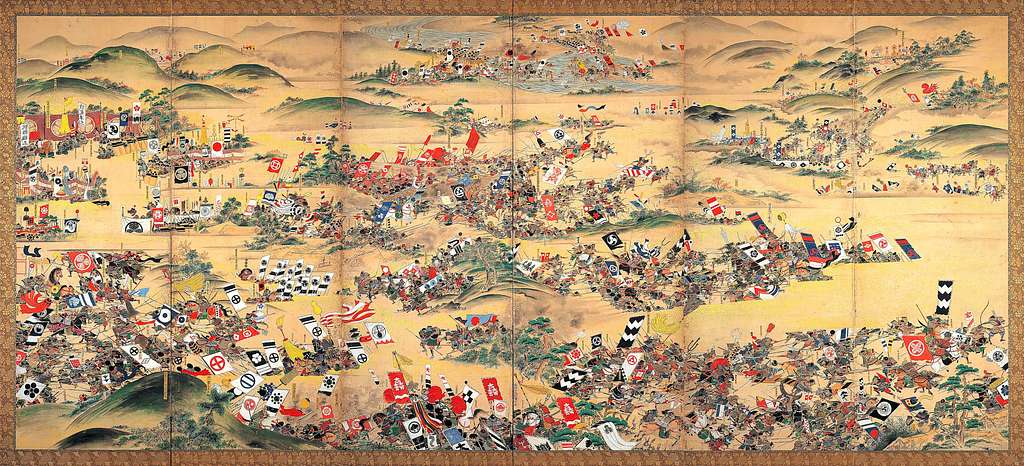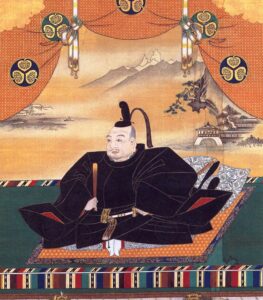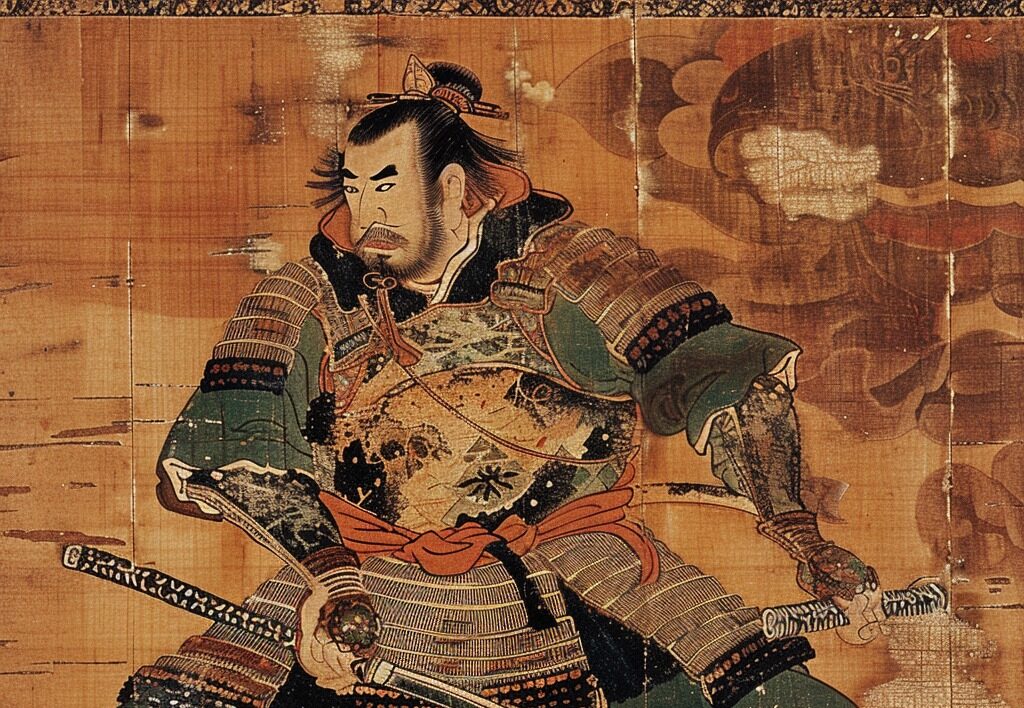Introduction
In the annals of Japanese history, few figures stand as prominently as Tokugawa Ieyasu, a man whose vision, strategy, and leadership not only ended a century of warfare but also laid the foundation for over two and a half centuries of unprecedented peace and stability. Born in a period marked by relentless conflict and political intrigue, Ieyasu’s ascent to power is a tale of resilience, cunning diplomacy, and military acumen. His most enduring legacy, the establishment of the Tokugawa shogunate in the early 17th century, heralded the beginning of the Edo period—a time characterized by economic growth, flourishing arts, and a strict social order that would govern Japanese life until the mid-19th century.
Ieyasu’s life and achievements encapsulate the tumultuous Sengoku period’s transition into the stable Edo era. Through his strategic marriages, pivotal battles, and shrewd governance, he not only navigated the complexities of warring feudal factions but also set the stage for an era of peace that allowed Japanese culture and economy to thrive. This introduction seeks to explore the remarkable journey of Tokugawa Ieyasu—from a hostage child to the paramount ruler of Japan—whose legacy is not merely confined to the annals of history but continues to permeate Japanese culture and identity to this day.
Early Life and Rise to Power
Birth and Early Childhood
Tokugawa Ieyasu, originally named Matsudaira Takechiyo, was born in 1543 in Mikawa Province, now part of modern-day Aichi Prefecture. His early years were marked by the turbulence of the Sengoku period, a time of near-constant military conflict and social upheaval in Japan. Ieyasu’s family was of minor nobility, struggling to maintain their standing amidst the power struggles that defined the era. His childhood was far from tranquil; at a young age, Ieyasu was thrust into the political complexities and violence that dominated the landscape of feudal Japan.
Hostage Politics
In the Sengoku period, it was common for daimyos (feudal lords) to take hostages from rival clans to ensure their loyalty and prevent rebellion. At the tender age of six, Ieyasu became a pawn in this game of power, when he was sent as a hostage to the Imagawa clan, a powerful neighbor. This experience, though harrowing, was crucial in shaping the young Ieyasu. It taught him valuable lessons in diplomacy, patience, and resilience—qualities that would define his leadership style in the years to come.
Alliances and Warfare
After regaining his freedom, Ieyasu set about consolidating his power in the region. He skillfully navigated the shifting alliances of the time, eventually aligning himself with Oda Nobunaga, a powerful warlord with ambitions to unify Japan. This alliance was strategic, providing Ieyasu with the military support needed to reclaim his ancestral lands and expand his influence. Throughout these years, Ieyasu demonstrated a keen understanding of the art of war and the importance of loyalty and honor in feudal Japan. His participation in key battles and sieges, such as the Battle of Anegawa and the Siege of Mikawa, cemented his reputation as a formidable warrior and a shrewd leader.
The turning point in Ieyasu’s rise to power came with his involvement in the Battle of Sekigahara in 1600, a decisive conflict that would eventually lead to his establishment of the Tokugawa shogunate. However, the path to this monumental battle was paved with years of strategic planning, alliance-building, and military engagements that showcased Ieyasu’s vision for a unified Japan under his leadership.
As Ieyasu’s power and influence grew, so did his ambitions. Through a combination of military prowess, strategic marriages, and political alliances, he was able to secure his position as one of the most powerful daimyos in Japan. His rise to power was not just a testament to his skill as a warrior and a leader, but also to his ability to navigate the complex and often deadly politics of the Sengoku period. Through his actions, Ieyasu laid the groundwork for what would become one of the most significant periods in Japanese history, setting the stage for his eventual unification of the country and the establishment of a lasting legacy.
The Battle of Sekigahara

Prelude to the Battle
The years leading up to the Battle of Sekigahara were characterized by significant political and military maneuvering among Japan’s most powerful daimyos. Following the death of Toyotomi Hideyoshi, Japan’s de facto leader, in 1598, the country was left without a clear successor. Hideyoshi’s young son, Toyotomi Hideyori, was seen as the legitimate heir, but his youth and the regency government established to govern in his stead created a power vacuum that ambitious daimyos sought to fill. Tokugawa Ieyasu, with his substantial military might and strategic acumen, emerged as a key figure in the ensuing struggle for power. The loyalty of various lords was split between those supporting the Toyotomi lineage and those backing Ieyasu’s bid for dominance.
The Battle Itself
The Battle of Sekigahara, fought on October 21, 1600, was the culmination of this power struggle. It was one of the most significant and largest battles in Japanese history, with over 160,000 men participating. The conflict was precipitated by Ieyasu’s decisive action against those aligned with the Toyotomi clan. Despite being outnumbered, Ieyasu’s strategic genius shone through. He skillfully managed alliances and positioned his forces advantageously, exploiting the terrain and the weaknesses of his adversaries. The battle was marked by fierce combat, betrayal among the Toyotomi ranks, and the eventual overwhelming victory of Ieyasu’s forces. The defection of key daimyos from the Toyotomi side to Ieyasu’s camp mid-battle played a crucial role in determining the outcome.
Aftermath
The victory at Sekigahara was pivotal for Ieyasu and the future of Japan. It effectively decimated the power of the Toyotomi clan and their allies, leaving Ieyasu in control of a vast majority of Japan. In the wake of the battle, Ieyasu moved quickly to consolidate his power, rewarding loyal followers with lands and titles, while punishing or diminishing those who had opposed him. The victory allowed him to establish the Tokugawa shogunate in 1603, with Ieyasu as the shogun, marking the beginning of a period of peace and stability that would last over 250 years. The battle not only determined the political landscape of Japan but also signaled the end of the Sengoku period, a century-long era of civil war, and the start of the Edo period.
The Battle of Sekigahara stands as a testament to Ieyasu’s military strategy, leadership, and vision for a unified Japan. It underscored the importance of loyalty, strategy, and the willingness to seize opportunities in the complex tapestry of Japanese feudal warfare. Through this decisive victory, Ieyasu laid the foundations for the Tokugawa shogunate, ushering in an era marked by significant political, social, and cultural developments that would shape Japan for centuries to come.
Establishment of the Tokugawa Shogunate
Following the decisive victory at the Battle of Sekigahara, Tokugawa Ieyasu found himself in an unprecedented position of power, with the ability to reshape Japan’s political landscape. The establishment of the Tokugawa shogunate was not merely the result of a military triumph but a carefully orchestrated effort to create a lasting peace and order throughout the land.
Founding of the Shogunate
In 1603, Ieyasu was officially appointed shogun by Emperor Go-Yōzei, marking the official establishment of the Tokugawa shogunate. This momentous occasion signified the transfer of power from the imperial court to the Tokugawa family, which would retain authority over Japan for the next 260 years. The choice of Edo (modern-day Tokyo) as the shogunate’s capital was strategic, signifying a shift away from the traditional power centers in Kyoto and establishing a new political and cultural hub.
Governance and Administration
Ieyasu’s approach to governance was characterized by a blend of military strength and astute administrative reforms. He implemented a system of alternate attendance (sankin-kōtai), requiring daimyos to spend alternating years in Edo and their home provinces, effectively keeping them under his control by straining their resources and preventing the formation of rival power bases. He also established a strict class system, solidifying the roles of samurai, peasants, artisans, and merchants, and enacted laws that regulated the social order and curbed the power of the Buddhist monasteries and Christian missionaries.
To ensure peace and order throughout the realm, Ieyasu and his successors developed a sophisticated bureaucracy, overseeing everything from infrastructure development to foreign trade. The Tokugawa legal code formalized samurai ethics and governance principles, emphasizing loyalty, honor, and duty. These measures, combined with a network of roads and post stations to improve communication and control, helped to stabilize the country and foster economic growth.
Social and Economic Impacts
The peace established by the Tokugawa shogunate had profound social and economic impacts on Japan. The era saw a significant increase in agricultural production, the rise of merchant classes, and the flourishing of urban centers. Peace and stability encouraged the growth of trade and commerce, both within Japan and with select foreign countries, despite the shogunate’s policy of sakoku (closed country), which restricted foreign influence and trade to a few designated ports.
The arts and culture experienced a renaissance during the Edo period, with the growth of kabuki theater, ukiyo-e woodblock prints, and the tea ceremony, reflecting the stability and prosperity of the era. The promotion of Neo-Confucianism as the official ideology supported the shogunate’s emphasis on order, hierarchy, and loyalty, further reinforcing the social structure.
Cultural Legacy and the Pax Tokugawa
The Pax Tokugawa, or the peace and stability achieved during the Tokugawa shogunate, set the stage for an extraordinary era of cultural flourishing and innovation in Japan. This period, marked by over two centuries of relative peace, allowed for the development of a rich cultural legacy that continues to resonate in contemporary Japanese society.
Peace and Stability
The effective governance strategies and policies implemented by Tokugawa Ieyasu and his successors facilitated a prolonged period of peace, known as the Pax Tokugawa. The absence of war and internal strife provided the necessary conditions for economic growth, social stability, and cultural development. This era allowed the Japanese people to turn their attention away from the concerns of conflict and towards the pursuit of artistic, intellectual, and cultural endeavors.
Cultural Flourishing
The Edo period witnessed a remarkable explosion in the arts and culture, fueled by the peace and prosperity of the time. Traditional arts such as tea ceremony (chanoyu), ikebana (flower arranging), and ink painting (sumi-e) saw new levels of refinement and popularity. At the same time, distinctively Edo-period cultural forms emerged, including:
Kabuki Theatre
Kabuki evolved into a sophisticated form of popular entertainment, combining drama, music, and dance to tell stories that ranged from historical epics to common folk tales. The vibrant costumes, elaborate makeup, and intricate stage mechanisms became hallmarks of kabuki theater.
Ukiyo-e Woodblock Prints

Ukiyo-e, or “pictures of the floating world,” captured the ephemeral pleasures of Edo life, from the beauty of the natural landscape to the vibrant urban nightlife. Artists like Hokusai and Hiroshige became renowned for their works, which continue to influence art worldwide.
Literature
The period also saw the development of distinctive literary forms, such as haiku poetry and the serialized novel. Matsuo Bashō’s haiku and Ihara Saikaku’s novels are just two examples of the era’s literary achievements, reflecting the values and concerns of Edo society.
Foreign Policies and Isolationism
Despite the shogunate’s policy of sakoku, which severely restricted foreign trade and interaction, the period was not entirely closed off from outside influence. Through limited engagement with the Dutch, Chinese, and Koreans, Japan was exposed to Western science, technology, and ideas. This selective openness allowed the shogunate to control external influences while still benefiting from foreign knowledge and goods.
Social and Economic Developments
The peace and stability of the Edo period facilitated significant social and economic developments. The rise of a merchant class and the growth of urban centers like Edo, Osaka, and Kyoto led to increased demand for entertainment, luxury goods, and cultural products. This consumer culture played a crucial role in the development of the arts, as artisans, craftsmans, and artists found new markets for their work.
The cultural legacy of the Pax Tokugawa is a testament to the profound impact of over two centuries of peace and stability on Japanese society. The arts and culture that flourished during the Edo period not only enriched the lives of people at the time but also left a lasting imprint on Japanese identity. From the vibrant performances of kabuki theater to the intricate beauty of ukiyo-e prints, the cultural achievements of the Edo period continue to captivate and inspire, underscoring the enduring legacy of the Tokugawa shogunate’s vision for a peaceful and prosperous Japan.
Final Years and Legacy
Tokugawa Ieyasu’s final years were marked by his continued efforts to ensure the stability and prosperity of the Tokugawa shogunate, setting the stage for its enduring influence on Japanese history. His legacy, deeply interwoven with the fabric of Japan, reflects the monumental impact of his rule.
Later Years and Death
After securing his power and establishing the Tokugawa shogunate, Ieyasu formally retired in 1605, passing the title of shogun to his son, Hidetada. However, retirement did not mean withdrawal from political life; Ieyasu remained active in governance, advising his son and ensuring the continued stability of the shogunate. He dedicated his later years to consolidating Tokugawa rule, promoting peace, and encouraging economic and cultural development. In 1616, Tokugawa Ieyasu passed away at the age of 73. His death marked the end of an era, but the foundations he laid for Japan ensured his influence would endure for centuries.
Lasting Impact
Ieyasu’s most significant legacy is the period of peace and stability that followed the establishment of the Tokugawa shogunate, known as the Edo period. Under Tokugawa rule, Japan enjoyed over 250 years of peace, marked by significant achievements in the arts, culture, and economics. This era saw the development of a distinct Japanese culture, the growth of a robust economy, and advancements in agriculture, science, and education. The social order and governance structures established by Ieyasu helped to maintain peace and foster a flourishing culture that enriched Japan’s national identity.
Ieyasu also left a lasting impact through his policies and governance model, which emphasized central authority, fiscal responsibility, and a pragmatic approach to foreign relations. His strategic use of marriage alliances, the system of alternate attendance (sankin-kōtai), and the codification of laws played crucial roles in maintaining the shogunate’s power and ensuring the loyalty of the daimyos.
Contemporary Relevance
The legacy of Tokugawa Ieyasu continues to be celebrated in Japan today. His life and achievements are commemorated in various cultural festivals, museums, and historical sites, particularly in his hometown of Okazaki and the city of Nikko, where his mausoleum, the Tōshō-gū shrine, is a UNESCO World Heritage Site and a symbol of his enduring legacy. The values of peace, stability, and cultural prosperity that characterized his rule remain integral to Japan’s national identity and cultural heritage.
Moreover, the lessons from Ieyasu’s leadership—his strategic thinking, diplomatic finesse, and vision for a unified Japan—offer timeless insights into the complexities of governance and the importance of visionary leadership.
Tokugawa Ieyasu’s final years and his enduring legacy are testament to his monumental impact on Japanese history. As the architect of the Tokugawa shogunate, his policies and leadership not only ushered in an era of unprecedented peace and cultural prosperity but also shaped the course of Japanese history for centuries. Ieyasu’s legacy, characterized by the stability and cultural richness of the Edo period, continues to influence Japan, celebrating the vision of a leader whose life’s work was dedicated to the unity and prosperity of his country.
Conclusion
Tokugawa Ieyasu’s journey from a hostage child to the unifier of Japan and the founder of the Tokugawa shogunate is a testament to his indomitable will, strategic genius, and visionary leadership. His life, marked by significant battles, strategic alliances, and shrewd governance, encapsulates a pivotal era in Japanese history. The establishment of the Tokugawa shogunate under his leadership heralded a period of peace and stability, the Pax Tokugawa, which allowed Japan to flourish in ways previously unimaginable during the tumultuous Sengoku period.
The legacy of Tokugawa Ieyasu is manifold and enduring. It is reflected in the 250 years of peace that followed his unification of Japan, a period that saw significant advances in culture, the arts, economy, and governance. The social structures, policies, and cultural innovations of the Edo period laid the groundwork for modern Japanese society, influencing its social norms, cultural practices, and national identity.
The story of Ieyasu’s rise to power, his establishment of a lasting shogunate, and the peaceful era that ensued, offers valuable lessons on leadership, diplomacy, and the importance of vision in governance. His ability to foresee the benefits of a unified Japan, coupled with his efforts to promote stability, economic growth, and cultural prosperity, underscore his legacy as one of the most influential figures in Japanese history.
In reflecting on the life and achievements of Tokugawa Ieyasu, it becomes evident that his impact extends beyond the historical and into the realm of the symbolic. He embodies the resilience, strategic acumen, and visionary leadership that continue to inspire and resonate with people not only in Japan but around the world. As we consider his contributions to Japanese culture, governance, and national identity, we gain insights into the values and principles that have shaped Japan’s path through history and continue to guide it today.
In conclusion, Tokugawa Ieyasu’s life and legacy represent a pivotal chapter in Japanese history, marking the transition from a period of war and uncertainty to one of peace and cultural renaissance. His influence is a reminder of the power of leadership and vision in shaping the destiny of a nation, making him a perennial figure of study and admiration in the annals of world history.

